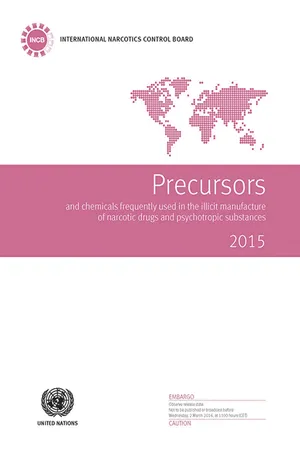
eBook - ePub
Precursors and Chemicals Frequently Used in the Illicit Manufacture of Narcotic Drugs and Psychotropic Substances 2015
This is a test
- 118 pages
- English
- ePUB (mobile friendly)
- Available on iOS & Android
eBook - ePub
Precursors and Chemicals Frequently Used in the Illicit Manufacture of Narcotic Drugs and Psychotropic Substances 2015
Book details
Book preview
Table of contents
Citations
About This Book
Prepared by the Board, this annual report presents an analysis of the information at its disposal and, in appropriate cases, an account of the explanations, if any, given by or required of Parties, together with any observations and recommendations which The Board desires to make. This report is submitted to the Economic and Social Council through the Commission, which may make such comments as it sees fit.
Frequently asked questions
At the moment all of our mobile-responsive ePub books are available to download via the app. Most of our PDFs are also available to download and we're working on making the final remaining ones downloadable now. Learn more here.
Both plans give you full access to the library and all of Perlego’s features. The only differences are the price and subscription period: With the annual plan you’ll save around 30% compared to 12 months on the monthly plan.
We are an online textbook subscription service, where you can get access to an entire online library for less than the price of a single book per month. With over 1 million books across 1000+ topics, we’ve got you covered! Learn more here.
Look out for the read-aloud symbol on your next book to see if you can listen to it. The read-aloud tool reads text aloud for you, highlighting the text as it is being read. You can pause it, speed it up and slow it down. Learn more here.
Yes, you can access Precursors and Chemicals Frequently Used in the Illicit Manufacture of Narcotic Drugs and Psychotropic Substances 2015 by United Nations Office on Drugs and Crime in PDF and/or ePUB format, as well as other popular books in Sciences physiques & Chimie analytique. We have over one million books available in our catalogue for you to explore.
Information
Topic
Sciences physiquesSubtopic
Chimie analytiqueAnnexes*
*The annexes are not included in the printed version of the present report but they are available in the CD-ROM version and in the version on the website of the International Narcotics Control Board (www.incb.org).
Annex I
Parties and non-parties to the 1988 Convention, by region, as at 1 November 2015
Note: The date on which the instrument of ratification or accession was deposited is indicated in parentheses.






a State member of the European Union.
b Extent of competence: article 12.
Annex II
Annual legitimate requirements for ephedrine, pseudoephedrine, 3,4-methylenedioxyphenyl-2-propanone and 1-phenyl-2-propanone, substances frequently used in the manufacture of amphetaminetype stimulants
1. In its resolution 49/3, entitled “Strengthening systems for the control of precursor chemicals used in the manufacture of synthetic drugs”, the Commission on Narcotic Drugs:
(a) Requested Member States to provide to the International Narcotics Control Board annual estimates of their legitimate requirements for 3,4-methylenedioxyphenyl-2-propanone (3,4-MDP-2-P), pseudoephedrine, ephedrine and 1-phenyl-2-propanone (P-2-P) and, to the extent possible, estimated requirements for imports of preparations containing those substances that could be easily used or recovered by readily applicable means;
(b) Requested the Board to provide those estimates to Member States in such a manner as to ensure that such information was used only for drug control purposes;
(c) Invited Member States to report to the Board on the feasibility and usefulness of preparing, reporting and using estimates of legitimate requirements for the precursor chemicals and preparations referred to above in preventing diversion.
2. Pursuant to that resolution, the Board formally invited Governments to prepare estimates of their legitimate requirements for those substances. Those estimates, as reported by Governments, were published, for the first time, in March 2007.
3. The table below reflects the latest data reported by Governments on those four precursor chemicals (and their preparations, as relevant). It is expected that those data will provide the competent authorities of exporting countries with at least an indication of the legitimate requirements of importing countries, thus preventing diversion attempts. Governments are invited to review their requirements as published, amend them as necessary and inform the Board of any required change. The data are current as at 1 November 2015; for updates, see www.incb.org/incb/en/precursors/alrs.html.
Annual legitimate requirements as reported by Governments for imports of ephedrine, pseudoephedrine, 3,4-methylenedioxyphenyl-2-propanone, 1-phenyl-2-propanone and their preparations, as at 1 November 2015
(Kilograms)




Notes: The names of territories, departments and special administrative regions are in italics.
A blank field signifies that no requirement was indicated or that data were not submitted for the substance in question.
A zero (0) signifies that the country or territory currently has no licit requirement for the substance. The letter “P” signifies that importation of the substance is prohibited.
Reported quantities of less than 1 kg have been rounded up and are reflected as 1 kg.
a 3,4-Methylenedioxyphenyl-2-propanone.
b 1-Phenyl-2-propanone.
c The Board is currently unaware of any legitimate need for the importation of this substance into the country.
d Includ...
Table of contents
- Cover
- Title
- Copyright
- Foreword
- Preface
- Contents
- Explanatory notes
- Chapter
- IV. Public-private partnerships: their merits and potential in preventing the diversion of chemicals
- Glossary
- Annexes*
- Notes